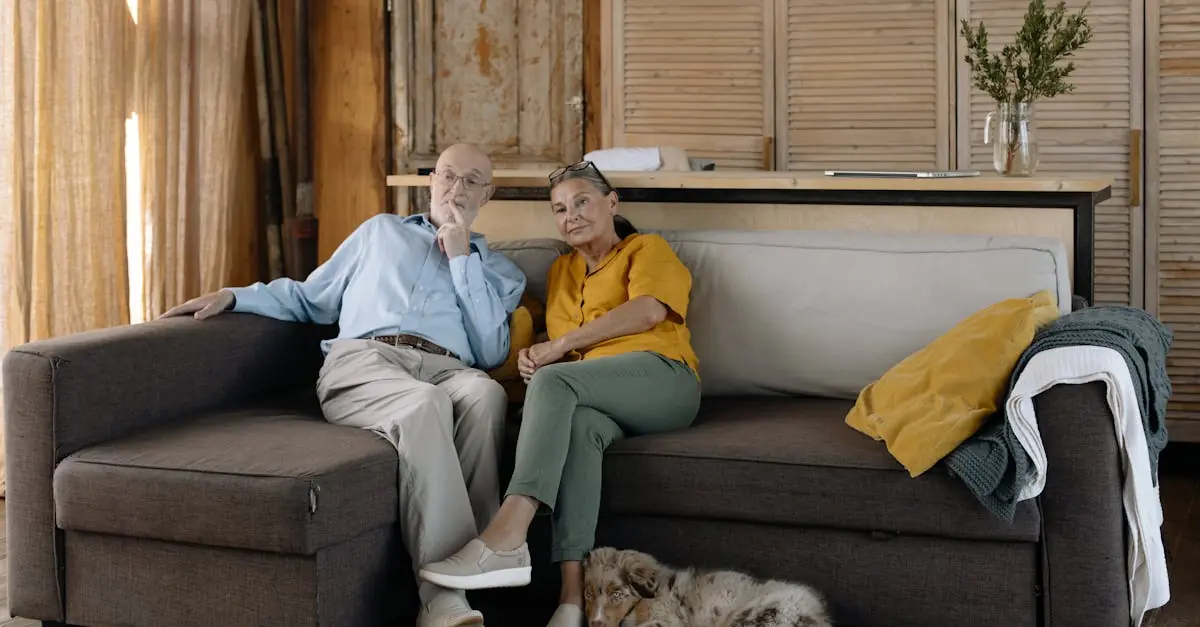As retirement approaches, many folks dream of sunny days, travel, and leisurely pursuits. But what about their furry companions? Pets are more than just four-legged friends; they’re family. And as retirees embark on new adventures, ensuring their pets have comfy accommodations becomes a priority.
Imagine a retirement community where your beloved pooch can lounge by the pool, or your curious cat can explore a garden paradise. This isn’t just a fantasy; it’s the new norm in retirement living! With the right pet accommodations, retirees can enjoy peace of mind knowing their pets are living the good life too. After all, who wouldn’t want their cat to have a retirement plan that includes sunbathing and birdwatching? Let’s dive into the world of retirement pet accommodations and discover how to make those golden years even more golden for both retirees and their furry pals.
Table of Contents
ToggleUnderstanding Retirement Pet Accommodations
Retirement pet accommodations focus on ensuring a comfortable and enjoyable living environment for pets in retirement communities. These arrangements play a crucial role in the overall well-being of both retirees and their pets.
Definition and Importance
Retirement pet accommodations refer to facilities and services that cater to the needs of pets in retirement settings. These environments enhance the quality of life for pets, allowing them to thrive alongside their owners. Ensuring pets are part of retirement planning is vital, as they provide emotional support and companionship. Accommodations that prioritize pets can lead to increased satisfaction for retirees, making their transition into retirement smoother. When retirees know their furry companions are well cared for, they can fully embrace their new lifestyle without worry.
Different Types of Accommodations
Several types of pet accommodations exist within retirement communities. Some communities offer dedicated pet-friendly housing options that include spacious living areas and secure outdoor spaces. Amenities such as dog parks, walking trails, and pet washing stations cater specifically to pet owners. Social activities often include pet meetups, allowing both pets and their owners to connect. Services like pet sitting, grooming, and walking can provide additional support. Different levels of care may also be available, ensuring that pets’ unique needs are met as their owners age.
Factors to Consider
When planning for retirement pet accommodations, several key factors play a vital role in ensuring the best environment for both retirees and their pets.
Size and Space Requirements
Size directly influences comfort and happiness for pets. Larger breeds typically need more room, while smaller animals might thrive in compact areas. Retirement communities should have ample space for pets to move freely. Outdoor areas like gardens and walking paths contribute significantly to their well-being. Additional spaces for activities, like designated play zones, cater to high-energy pets.
Accessibility Features
Accessibility greatly impacts both pets and their owners. Communities equipped with ramps and elevators simplify mobility for retirees with limited physical capabilities. Designated pet relief areas can prove pivotal in ensuring that pets easily reach their needs without stress. Furthermore, walking trails that accommodate various mobility devices benefit everyone, encouraging a leisurely pace for bonding moments.
Safety and Security
Safety concerns must be a priority in retirement pet accommodations. Secure fencing in outdoor areas prevents pets from wandering off, offering peace of mind. Additionally, features like surveillance cameras can enhance security for all residents. Clear pathways and well-lit areas reduce risks of accidents during evening walks. Emergency protocols should be clear and accessible to ensure swift assistance if needed.
Popular Retirement Pet Accommodation Options
Various accommodations cater uniquely to retirees and their pets. These options enhance the retirement experience while ensuring pets remain happy and well cared for.
Assisted Living Facilities
Assisted living facilities often prioritize pet-friendly policies, fostering an inviting environment for retirees and their companions. Many offer dedicated areas for pets to roam and interact. In some cases, residents can participate in regular pet activities such as training or social events. Additionally, staff members frequently engage with pets, ensuring interaction and companionship for both retirees and their animals.
Pet-Friendly Community Housing
Pet-friendly community housing provides an excellent alternative for retirees seeking independence while accommodating their furry friends. These properties typically feature amenities like pet parks and walking trails. Residents enjoy easy access to outdoor spaces where pets can explore. Housing options also vary in size, making it easier for retirees to find a suitable living arrangement for their specific needs.
In-Home Care Services
In-home care services cater specifically to retirees who wish to remain in their homes while receiving assistance. These services often include pet care components, allowing caregivers to help with tasks such as walking dogs or feeding pets. Seniors benefit from companionship, knowing their beloved animals receive quality care. Such services enhance overall well-being, aiding both retirees and their pets in maintaining a fulfilling lifestyle.
Benefits of Retirement Pet Accommodations
Retirement pet accommodations significantly improve the experience for both retirees and their pets. Ensuring pets have adequate facilities contributes to overall happiness and companionship.
Enhanced Quality of Life
Retirees enjoy a higher quality of life with well-designed pet accommodations. Access to pet-friendly amenities encourages outdoor activities. Clean walking trails and spacious parks promote exercise for both pets and their owners. Pets benefit from engaging in social interactions with other animals, reducing boredom. Pet-friendly communities often organize activities for owners and their pets, fostering deeper connections. Improved living conditions for pets lead to greater contentment for their owners as well.
Companionship and Emotional Support
Pets serve as vital sources of companionship and emotional support during retirement. Their presence helps alleviate feelings of loneliness or isolation. Seniors often find joy in caring for pets, which adds purpose to their daily routines. Emotional well-being improves when retirees can spend quality time with their pets in a nurturing environment. Bonding activities, such as pet grooming or walking, offer opportunities for physical connection and emotional engagement. Pets also provide unconditional love, contributing positively to mental health and overall satisfaction in retirement.
Conclusion
Retirement pet accommodations play a crucial role in enhancing the lives of both retirees and their furry companions. By prioritizing pet-friendly environments and services, retirees can ensure their pets enjoy a fulfilling lifestyle alongside them. This thoughtful planning not only improves the quality of life for pets but also provides essential emotional support for their owners.
As retirees embrace this new chapter, focusing on the well-being of their pets can lead to deeper connections and greater happiness. The right accommodations pave the way for shared experiences that enrich daily routines and foster a sense of community. Ultimately, creating a harmonious living space for both retirees and their pets is key to a rewarding retirement journey.







